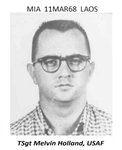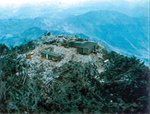



Woodland’s American Veterans (AMVETS) Post 16 will soon feature a name in dedication to a technical sergeant in the U.S. Air Force who was one of nearly a dozen Americans who were unaccounted for following a 1968 attack on their top secret radar post in Laos during the Vietnam War.
At 1 p.m. on Nov. 6 at the Woodland VFW post at 434 Davidson Ave., AMVETS Post 16 will dedicate its name to Melvin A. Holland, a former resident of the city who went missing in action following an enemy attack on Lima Site 85 in northern Laos on March 10, 1968. The dedication will include the unveiling of a memorial with Melvin Holland’s name on it as well as a POW/MIA “honor chair.”
Post 16 was chartered two years ago and is the newest in the state of Washington, AMVETS Post 16 Commander Chuck Lashley said. Local members of the Patriot Guard Riders decided to form the post after the city had been without AMVETS representation for more than a decade.
Formation of the post allows members to participate in rifle volleys and the playing of Taps at military memorials. Woodland’s prior post was also dedicated in Melvin Holland’s name, Lashley said.
“We don’t want his memory to be lost,” Lashley said.
Melvin Holland’s son, Rick Holland, will dedicate the POW/MIA honor chair to the post. Lashley said the chair symbolizes that the post always has a seat open for any prisoners of war or those who went missing in action should they return.
Rick Holland recalls saying goodbye to his father on his eighth birthday on Oct. 7, 1967. The next day, Melvin and his wife, Ann, flew out to Washington, D.C. for a final briefing and an administrative discharge from the military followed by an immediate hiring by the Lockheed Corporation, his son said.
Melvin Holland was one of 50 men selected for a top secret mission, Rick Holland said. His father was tasked with maintaining and operating a radar site on a mountaintop in northern Laos. The discharge and immediate hiring as a civilian was a way to skirt the prohibition on military operations in the ostensibly neutral country.
Rick Holland said the site was codenamed “Commando Club” and those who operated it were called “Circuit Riders.” He said the radar was used to assist bombing runs in Vietnam, allowing for missions during the monsoon season when they were otherwise impossible.
The site operated from Nov. 1, 1967, until the evening of March 10, 1968, “when the Vietnamese had had enough,” Rick Holland said, launching a “full-scale attack” on the base.
Rick Holland said the men at the base weren’t trained in escape and evasion and only had modest protection. Only five of the men were evacuated off the site the next morning, he said.
Rick Holland’s mother learned something had happened the day after the attack and received periodic phone calls, all while being unable to tell anyone what was going on due to the secrecy behind the base.
“I had to hang up the telephone and turn around and face my own five little children as well as eight little cub scouts and pretend that nothing was wrong. I had to go through the next three months pretending nothing was wrong,” Ann Holland said during Congressional testimony in 1996. “When my children would come running in from school and want to know if we had gotten a letter from Daddy, I would take out an old letter and pretend to read it. When Mel’s sisters would ask how he was doing, I would have to tell them fine.”
It took two years before Melvin Holland was declared dead, his son said. He was one of 11 Americans unaccounted for at the site.
In the years since, Rick Holland said there have been reports of Americans in Russia whose circumstances matched what happened at the radar site. Nothing has been confirmed by the U.S. Air Force, however, much to the frustration of Melvin Holland’s survivors
“My mother’s been fighting them for 55 years. I then picked up the fight,” Rick Holland said.
The Defense POW/MIA Accounting Agency (DPAA) has been out to the site to conduct forensic testing to find remains, Rick Holland said. In 2005, bone fragments were identified as being from Patrick Shannon, one of the men who was initially unaccounted for. In 2012, the site commander, Clarence Blanton, was also identified.
Nine of the Circuit Riders still remain unidentified, including Melvin Holland. His son said he has been pushing the DPAA to conduct more investigation at the site. He said time is running out to make any discoveries given the environment’s effect on remains.
“They can’t wait to go five years from now, 10 years from now,” Rick Holland said.
Lashley said the secrecy behind Melvin Holland’s mission and the years of forced silence for his wife stuck out to him.
“His story is one of 58,000 that we lost in Vietnam,” Lashley said.
Rick Holland maintains a website about the site and its story online at limasite85.com. His own life mirrored his father’s. He joined the Air Force and has a career as a radio communication systems engineer.
He said his goal is to provide closure to his mother and to do right by his father.
“I do whatever I can to honor him, and my mission in life is to bring him and the other guys home,” Rick Holland said.